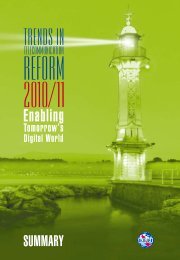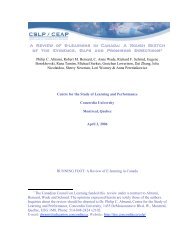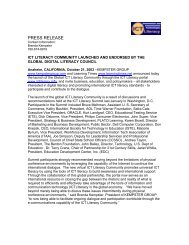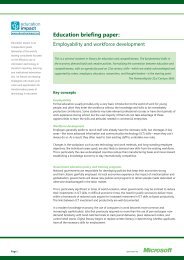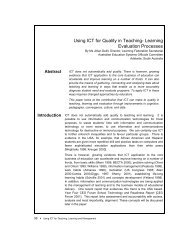147 pages pdf - ICT Digital Literacy
147 pages pdf - ICT Digital Literacy
147 pages pdf - ICT Digital Literacy
Create successful ePaper yourself
Turn your PDF publications into a flip-book with our unique Google optimized e-Paper software.
Pedagogy & Webagogy -- Ready, Set … TRAIN and FACILITATE!<br />
#533: Take Note: Get Organized!<br />
Script your handout with everything you plan to say. Print it out, with your remarks in a different<br />
color than the headings that the participants see and put them in page protectors in a 3-ring<br />
binder. Then print out your slides (if using PowerPoint, print as handouts 3 to a page), and also<br />
put them in page protectors and in a 3-ring binder. Have both binders on your desk. You will<br />
now be fully prepared because you can devote the bulk of your energy and attention to<br />
interacting with your participants, knowing what you will say, what they will see, before they do.<br />
Doug Chasick<br />
CallSource<br />
#534: A "Level Setting" Success Story<br />
In moving to a blended solution several years ago, students, service and support technicians who attend<br />
classroom training are required to go to a training web site to take a prerequisite first. The course includes<br />
flash or video for various topics such as: A Product Tour (which contains a product walk around, statistics<br />
related to a product, marketing information ...), Setup and Configuration (shows how to set a product up in<br />
a customer site), and Use and Maintenance. When the student attends class, there is a quiz to reinforce<br />
the data in the prerequisite. This has worked well to ensure all are at the same starting place before the<br />
Instructor Led class.<br />
Laddene Korhonen<br />
Hewlett-Packard<br />
#535: Getting Everyone Up-To-Speed<br />
Use short, content-focused e-Learning modules to level the playing field prior to classroom<br />
discussions. This enables the classroom sessions to focus on interaction, activity and<br />
application instead of static content.<br />
Mark Hetrick<br />
Aetna, Inc.<br />
#536: People Love A Challenge<br />
Turn management e-Training (soft skills training) into e-Learning by issuing a challenge to the<br />
learner. At the end of the lesson, give them a challenge to test the concept or skill within the<br />
next week/month (depends on the frequency with which the knowledge/skill can be applied).<br />
The idea is to get them to prove to themselves that the skill/knowledge has value to them and<br />
that the lesson has credibility. Not everyone responds but some do. And others do the "test" and<br />
don’t email us but they transfer the learning to the work site which is what counts.<br />
Jerry Moran<br />
Hilton<br />
#537: Be Natural<br />
Use direct language when giving instruction in online sessions. Use the same sort of language you would use<br />
if you were meeting the learners face-to-face. For example. I use headings such as: What is this module<br />
about? What do I need to do to pass it? This is how I would handle the situation in person.<br />
Pam Atkins<br />
Swinburne University of Technology<br />
#538: Count Down To Involvement<br />
I typically have 8 to 10 people in a class. At the start of class I let everyone know that I will be<br />
asking individuals for comments or to respond to questions. I keep notes with each participant's<br />
name above my monitor window and mark them as I ask questions or get comments. This helps<br />
me to make sure everyone is participating and is engaged.<br />
Bill C Marquis<br />
Hallmark Cards, Inc.<br />
701 e-Learning Tips by The MASIE Center www.masie.com 107






